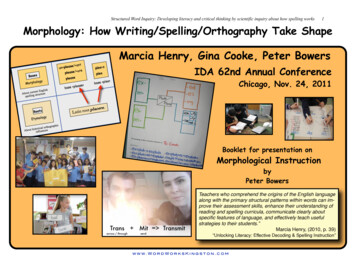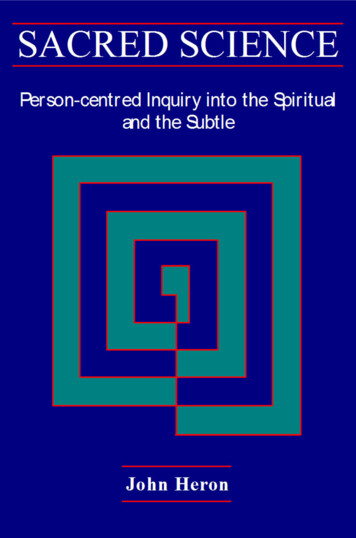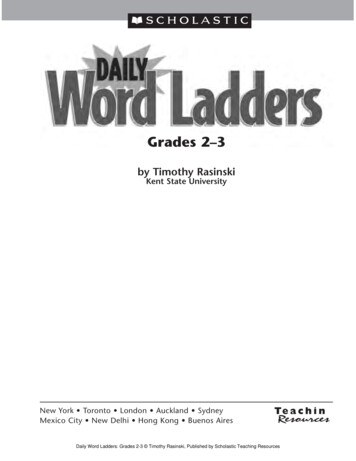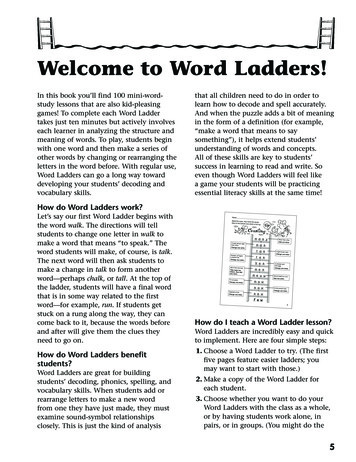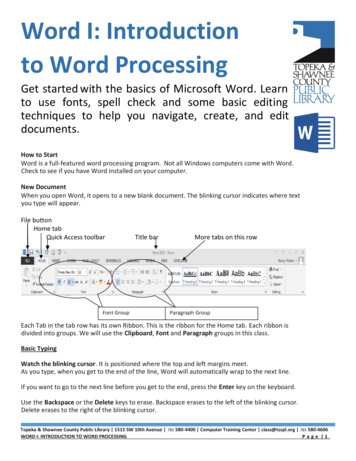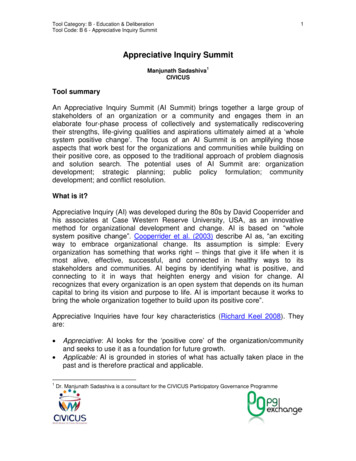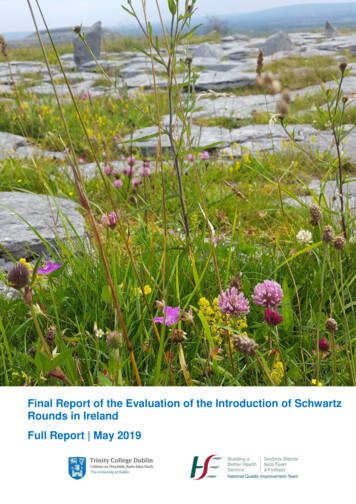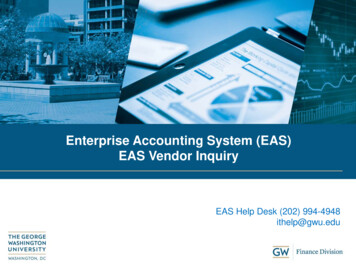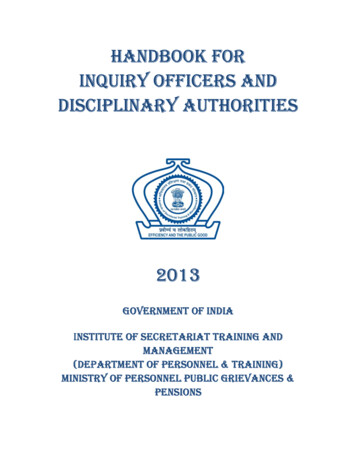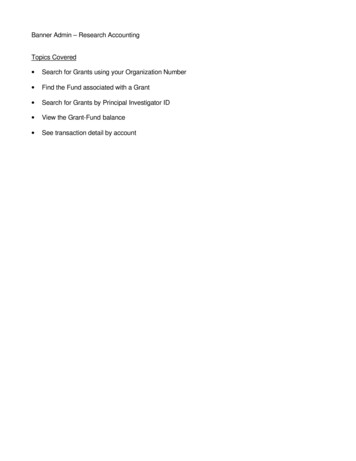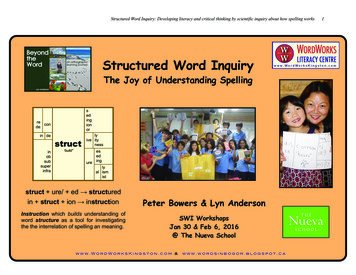
Transcription
Structured Word Inquiry: Developing literacy and critical thinking by scientific inquiry about how spelling worksStructured Word InquiryThe Joy of Understanding Spellingstruct ure/ ed structuredin struct ion instructionInstruction which builds understanding ofword structure as a tool for investigatingthe the interrelation of spelling an meaning.Peter Bowers & Lyn AndersonSWI WorkshopsJan 30 & Feb 6, 2016@ The Nueva Schoolwww.WordWorksKingston.com &www.wordsinbogor.blogspot.ca1
Structured Word Inquiry: Developing literacy and critical thinking by scientific inquiry about how spelling works2Guides for Structured Word InquiryTwo Guiding Principles of Structured Word InquiryA model of English orthography from www.realspelling.comThe primary function of English spelling is to representmeaning.The conventions by which English spelling representsmeaning are so well-ordered and reliable that spellingcan be investigated and understood through scientificinquiry.Scientific inquiry is necessary to safely guide spelling instructionand understanding.Scientific inquiry is the only means by which a learningcommunity can safely accept or reject hypotheses abouthow spelling works.Click here for a full draft document expanding on these ideas,including definitions of key concepts and terms.Process of “Structured Word Inquiry”1) Prompt learners with an interesting spelling question.(e.g., why g in sign ?)2) Strategically present a set of words that makes the relevantpattern more salient.3) Help learners hypothesize a solution from carefully presented evidence.4) Guide testing of learners’ hypotheses and identify the precise convention that explains the original question.5) Practice the identified pattern with appropriate tools (e.g.,word sums, flow charts).See more on structured word inquiry, and the difference between“teacher-led inquiry” and “inquiry-led teaching” at this link.www.WordWorksKingston.com &www.wordsinbogor.blogspot.ca
Structured Word Inquiry: Developing literacy and critical thinking by scientific inquiry about how spelling works3What is crazy -- the English spelling system, or our typical systems for teaching spelling?Consider the frustration experienced by the student in this story. The teacherdoes the best his training allows as he tries to help his student deal with yetanother “irregular” spelling. Imagine the consequences for learning when suchexperiences are repeated over and over.“Know More Explosions”Excerpt from a Grade 4 teacher’s emailMy program is for junior students identified with behaviourproblems, problems which make their full-time participationin "standard" classrooms problematic for everyone involved.Most of our students have ADHD identifications, often coincident with LDs and other difficulties, and virtually all of themread more than two grade levels lower than they should. Inmany instances, the students' behaviour difficulties and theirlanguage deficits pose a chicken-and-egg question.In a guided reading session I was doing with a burly and eager Grade 4 student reading at PM 9, the student pointed tothe work "know" and asked what it said. Knowing my students, I prepared him for my answer with "OK, this is goingto blow your mind, but . . . ." When I finished with "It says/no/," he didn't miss a beat. He tore the book off the tableand flung it across the room. And then he started: "It doesnot f*#!ing say 'no!' " - giving the whole class a languagelesson as he tore a path toward the classroom door - " k says /k/ and w says /w/, so it does not say f*#!ing 'no' !"How am I supposed to learn this sh*!t when the ruleschange? K f*#!ing says /k/!"After the student de-escalated - and being told that knight says /night/ DIDN'T help, I promised him I'd find outwhy that word is pronounced as it is.RobbCursing our crazy spelling system seems like a naturalresponse to Robb’s story about the struggle to learn andteach reading and spelling in English. It would be so mucheasier if we just had a reliable, logical spelling system!Ironically, it turns out that our spelling system does meetthese exact criteria. Unfortunately this assertion seemsabsurd in light of the instruction most of us have received.It is important to recognize, however, that the commonassumption of English spelling as an unreliable,exception-riddled system is a hypothesis that can betested.The science of spelling: Scientific inquiry of the conventions of English spelling provides plenty of evidence thatour spelling system is an extremely reliable and orderedsystem for representing the meaning of words to Englishspeakers. (e.g. Carol Chomsky, 1970).There is obviously much more to spelling than morphology. However, scientific analysis of English spelling makesit clear that we cannot make sense of our spelling systemwithout morphological understanding.Orthographic morphology is the conventional system bywhich spoken morphemes are written. Instruction can direct the attention of learners to this concrete representation of the meaning structure of words. Students can usemorphological knowledge gained through instruction todefine words they were not taught, but which are morphologically related to words that they were taught. (Bowers &Kirby, 2010). However, teaching morphology is not onlyabout showing learners how bases and affixes can beused to learn new vocabulary.Click here for lessons investigating the spelling of know inspired by Robb’s story.www.WordWorksKingston.com &www.wordsinbogor.blogspot.ca
Structured Word Inquiry: Developing literacy and critical thinking by scientific inquiry about how spelling worksTouching on the ResearchResearch has long emphasized the importance of letter-soundknowledge for literacy development (e.g., Adams, 1990; Rayner et al., 2001). There is an enormous amount of researchshowing that instruction which explicitly teaches graphemephoneme correspondences and phonemic awareness is moreeffective that “whole word” based instruction which does notemphasize the internal structures of words. That evidence,however, says nothing about the effect of teaching about morphology, or the interrelation of morphology and phonology.Nevertheless, many researchers and research models recommended not addressing morphology until later years. In herseminal 1990 book, Adams wrote,“Although teaching older readers about the roots [basemorphemes] and suffixes of morphologically complexwords may be a worthwhile challenge, teaching beginning or less skilled readers about them may be a mistake” (p. 152).The following 20 years of research largely behaved as thoughthere was clear evidence supporting this hypothesis. In 2010meta-analyses of morphological interventions were finallyconducted (Bowers & Kirby, 2010; Goodwin & Ahn, 2010;2012) to test that assumption. The exact opposite was found.Not only did morphological instruction help students in general, less able and younger students gained the mostfrom morphological instruction. Devonshire, Morris, &Fluck (2013) Conducted an intervention with 5-7 year olds thatcompared an experimental group with instruction of the interrelation of morphology, phonology and etymology with wordsums and matrices to best practice phonics like instruction.They found significant effects on standardized measures ofreading and spelling for the experimental group. There is noresearch evidence showing that phonology needs to be taughtbefore morphology.www.WordWorksKingston.com &4Meta-Analyses & Reviews of Morphological interventionsThe best evidence is that we should teach how the writing systemworks from the start. See a teacher friendly review of the researchhere.It makes sense that learning letter-sound correspondences wouldbe facilitated by a fuller understanding of how they operate withinthe morphological frame. As linguist Richard Venezky pointed outlong ago, "the simple fact is that the present orthography systemis not merely a letter-to-sound system riddled with imperfections,but, instead, a more complex and more regular relationshipwherein phoneme and morpheme share leading roles" (Venezky,1967, p. 77).Teachers need to know about more than morphology to explainthese spellings, but establishing the morphological structure of aword is a necessary part of that process, even for base words.www.wordsinbogor.blogspot.ca
Structured Word Inquiry: Developing literacy and critical thinking by scientific inquiry about how spelling worksIs does really an irregular spelling?Typically instruction leads children to believe that does is one ofmany irregular spellings they have to memorize. In contrast, the word goes is treated as regular.See how the matrix and word sums below make sense of these spellings by providing a concrete representation of the interrelation ofstructure and meaning of the do and go word families.A morphological matrix for do and go dogoingesneWord Sums for do and go go ing goingdo ing doinggo es goesdo es doesgo ne gonedo ne doneWith these linguistic tools, children can be introduced to does asan ingenious spelling because it marks its meaning connection to itsbase do with a consistent spelling. The spelling structure of theseword families is a brilliant opportunity to show children why it is usefulthat most letters (graphemes) can represent more than one pronunciation. Only in this way could the spelling of do and does usethe same spelling of the base!Instead of adding it to a list of irregular words, teachers who understand morphology can use the spelling of a word like does to introduce children to the ordered way their spelling system works.“Teachers who consider English a chaotic and unprincipled writing system likely foster a similar view among their students. Such pupils maynot look for patterns in the system because they believe that few existto be discovered. Teachers who appreciate the writing system can helpstudents find its patterns, fostering a positive attitude about spelling”Treiman and Kessler (2005, p. 133)www.WordWorksKingston.com &5Links to Structured Word Inquiry VideosClick here for a tutorial video showinghow beginners can use the Word Microscope to guide an investigation througha stud of the word discovery .Click here for an inspiring video on LynAnderson’s “Beyond the Word” Blot. Itshows 5-year-old students investigatingthe word carnivore and some of itssurprising relatives in Etymonline.Click here for a video of a tutoring session with a 7-year old investigating themeaning-spelling connections betweenwords with the matrix and word sum.Click here for an inspiring video / postfrom a Grade 5 public school with students describing their experience learning through structured word inquiry. Seea WW Update on this post here.Click here to see Etymonline authorDouglas Harper discuss an investigationwith Pete linking spice with manysurprising relatives. So rich!Click here for a Grade 7 student explaining his understanding of the political world through linguistic analysis ofthe word dissent . Explore a bank of videos of structured word inquiry in classrooms at this YouTube page. See the process of SWI investigations (inc. videos) at THISNEW ARCHIVE.www.wordsinbogor.blogspot.ca
Structured Word Inquiry: Developing literacy and critical thinking by scientific inquiry about how spelling worksThe word matrixThe morphological matrix isa map of the interrelation of structure andmeaning of written word Latin Rootquaerereion‘ask, seek, gain’sableingThe word matrix marks the only feature of anorthographic morphological family that is stable the underlying orthographic representation of itsmorphemes. These representations correspondto what Carol Chomsky (1970) called “lexicalspellings.”The pronunciation and connotation of a morpheme can vary across members of a family. Thelexical spelling of a morpheme -- that is capturedby word sums and matrices -- remains stable.base spelledbase pronouncedmatrixquest ion question/kwɛst/in quest inquestingesnebase spelled do Interrelation of graphemesand morphemesGraphemes comprised of single letters or2- or 3-letter teams that represent a phoneme. They occur within morphemes.Possible phonological representations of agrapheme are signaled by circumstances.The diagram above shows three of thepossible phonological representations ofthe t grapheme. Two of these are realized in the words of the quest matrixshown on this page.Note that since the o and the e graphemes in does are not in the samemorpheme, there is no oe digraph inthis word.Word Sums (examples listed by pronunciation of base)/kwɛstʃ/ quest doThe word matrix represents members of an orthographic morphological word family. Such word familiesshare a connection in both structure and meaning.(Real Selling tutorial films on morphology here.) structure: common underlying spelling of the base meaning: common ultimate etymological origin of thebaseInclusion of a word in a matrix is tested with a wordsum. The word sum isolates the constituent morphemes (bases and affixes) on one side of the rewritearrow (marking all morphological suffixing conventions)and on the other, the realized surface structure of theword.An “echo” of the denotation of the root meaning of thebase of any word represented by a matrix can be detected in the connotation of that realized word. The denotation of the root meaning of a word is checked withan etymological reference (e.g. etymonline.com).6base pronounced/du://dʌ/www.WordWorksKingston.com &quest ion able questionablecon quest conquestre quest ed requestedWord Sums (examples listed by pronunciation of base)do ing doingdo es doesdo ne donewww.wordsinbogor.blogspot.ca
Structured Word Inquiry: Developing literacy and critical thinking by scientific inquiry about how spelling worksAlternate investigations of the same word family.Investigate the structure of knowledge !Grade 4s investigate the structure of knowledge !Circle the base know Write out the word sum for each word. Spell it out-loudas you write it! Remember to announce the kn and ow digraphs, and pause at the plus signs!1. Analyze these words with word sums according to the hypothesis thatthey share the base know . (Can you prove all the affixes?)2. Represent analyzed words in the -n-s-ledge -ablewww.WordWorksKingston.com &www.wordsinbogor.blogspot.ca7
Structured Word Inquiry: Developing literacy and critical thinking by scientific inquiry about how spelling works8Structured Word Inquiry Activities.See next page for a description of how to use the “structured andmeaning test” to see clarify this task and for links to related resources.www.WordWorksKingston.com &www.wordsinbogor.blogspot.ca
Structured Word Inquiry: Developing literacy and critical thinking by scientific inquiry about how spelling works9Structured Word InquiryWhat words are in the middle?Etymological and Morphological RelativesmodeL. mod(us) "measure,extent, quantity;proper measure."middlemilieu(French)mean(as in “average”)meridianLatin medi(us) "middle, between"Etymological familyMorphological familyAll the words within the oval (including those represented by thematrix) are in the same etymological family because they sharethe Latin root ‘medi(us)’ with the sense of “middle, between”.The words represented by the matrix with the bound base medi share not only that same root, but they also share thesame base element spelled medi . To test whether a wordbelongs in this matrix, ensure that is has the same root, and thenconstruct a word sum linking to the base medi .Note that mode is not in the circle (etymological family) because ithas a different root. See how the words middle and median can share a meaning without sharing a base? When you understand the math concepts of median , mean and mode , why does it make sense that median and mean are related by a family that has to do with the idea of “between, middle” but mode is NOT related? Which sense, extent, quantity or proper measure, do you associate with the math concept of “mode”?www.WordWorksKingston.com &www.wordsinbogor.blogspot.ca
Structured Word Inquiry: Developing literacy and critical thinking by scientific inquiry about how spelling works10Etymological and Morphological Relatives of the Free Base Element sense Word Sums for sense matrixsentinelsense/ or sensorsense less senselessnon sense nonsensesense/ ibly sensiblydis sense/ ion dissensioncon sense/ us consensussense/ ibility sensibilitysense/ ate/ ion sensationLatin ‘sent(ire), sens(us)’"to perceive, feel"Paragraph for sense Decision by consensus vs majority ruleIt is more difficult for a group to arrive at a consensus on a decision compared to majority rule. That hard work, however, helps everyone feel thattheir opinions have been heard and respected.Observations / Reflections / Questions At first I had just the sense matrix, but then I noticed that three of mywords shared the sent base, so I added the second matrix. I was not sure how to analyze sentinel . I didn’t know what to do withthe inal part, so I left sentinel as a base for now. Since it seems tobe in this etymological family I left it in the circle.Word Sums for sent matrixdis sent dissentsent i ment sentimentsent ence sentence The suffixes -ibility and -ibly made me wonder. It is hard to believe -ibility is just one suffix. We tried -ible ity , but this doesn’t explainthe i . The Oxford describes -ibility as a suffix forming nouns andgives the example of accessibility which works with a word sum withthe base or stem access . Until I find a way to analyze -ibility deeper, I will treat it as a suffix until I find a deeper analysis. I wonder if there are more morphological families that grow from theLatin root ‘sent(ire)’. I’m curious to better understand the connection between the idea of“perceive, feel” and the word sentence . I’m curious about the Latin root “sensus’ for “perceive feel” too. I wonderif that explains the spellings sense and sent . I’ve heard of ‘twinbases’ and wonder if that might relate here.WrodmWotdosni .ncboomg o r . b l o g s p o t . c aw w w . W o r d W o r k s K i nwgwswtono.c&r kwswKwi .nwgosr
Structured Word Inquiry: Developing literacy and critical thinking by scientific inquiry about how spelling worksNameWordWorks Lessons! by Peter Bowers, 2007,www.wordworkskingston.comActivity Sheet #1When does Suffixing Cause Changes at the Joins?A) Investigation: Developing a hypothesisStudy the matrix for move and the word sums created from it tosee if you can discover a consistent suffixing pattern.signBuild words with your cut out prefixes and suffixes on the base sign . Once you have built aword, write the word sum as modeled in 1 and 2.Part A:prefix(es)-base - suffix(es)1) sign al signal2) as sign ment assignmentBased on (Ramsden 2001) www.realspelling.comLesson #2: Spelling DetectivesWord Building: Using a Real Spelling Word MatrixA WORD MATRIX USUALLY ONLY SHOWS SOME POSSIBLE WORDS. YOU CAN OFTENFIND MORE IF YOU TRY!Rules for reading a word matrix:al Read a matrix from left to right.reing Make only single, complete words from a matrix.ed Only build words you can use in a y column of a matrix – BUT.ment You must not ‘leapfrog’ over a column.re deate ure WATCH THE JOINS! Sometimes changes happenwhere you add a suffix.11Word Sums from move Matrix(Draw a line through silent e s replaced during suffixing as shown in the second sum.)reunmovesingedermentmove smove ingmove edmove ermove mentre move edre move erun move verunmoved1. What is the change that sometimes occurs at the suffix join?3) 4) 5) 2. List the suffixes that cause the change:3. List the suffixes that cause no change:4. How are these suffixes different from each other?6) 7) 8) 5. Our class’ hypothesis to explain how you know which suffixes mayforce a change at the join:9) 10) Real Spelling Tool Box Connection3E - The base elements sci and sign Real Spelling Tool Box Connections1K - Learning from Love (Learn about the letter v )3A - Revisiting Suffixing (Learn many roles of the single, silent e 128www.WordWorksKingston.com &www.wordsinbogor.blogspot.ca
Structured Word Inquiry: Developing literacy and critical thinking by scientific inquiry about how spelling worksWordWorks Lessons! by Peter Bowers, 2007,www.wordworkskingston.comWordWorks Lessons! by Peter Bowers, 2007,www.wordworkskingston.comActivity #3Flow Chart for Dropping the Single, Silent e During SuffixingB) Testing our Hypothesis:These matrices build on base words (a one morpheme word - no prefix or suffix) that end withthe letter ‘e’. Create word sums from a variety of the matrices to test our class hypothesis. (You don’tneed to build every possible word from each matrix to test the hypothesis.) Be ready to share interesting discoveries with the class. Any surprising findings, or wordswhose pronunciation changes when you add affixes?disdispleaseagreemis beingenrehopetakeInstructions: On a separate page, rewrite the beginning of the word sum provided. Use the flow chart to identify the correct spelling when fixing the suffix to the base. When a silent e is replaced by a vowel suffix, cross it out on the left or the “rewritearrow” before competing the spelling on the left side of the arrow.singedfullesssingenoutsingedour (Can)ior (US)beuningedmentablehaveBased on (Ramsden 2001) www.reaslspelling.comBased on (Ramsden 2001) www.realspelling.comLesson #2 Continued esedanture12Example: date ing ! datingenlargeeseringedlyishWord Sums1.2.3.4.5.6.7.8.9.10.ment sReal Spelling Tool Box Connections1D - The effect of suffixes on a single, silent e 1B - Making plurals - 1- whether to use -es or just -s 3G - The end of base words dge or just ge ? the suffix -age (understanding the silent e in large 1G - ‘long’ and ‘short’ vowels and the single, silent e 1I - Homophones -1- (Make sense of the silent e in please 1H - Compound words -1- (Does takeaway break suffixing conventions?15www.WordWorksKingston.com &cave ed !create or !require ment !smile ing !rude ly !brave est !brave ly !include ing !lone ly !close ness !11.12.13.14.1516.17.18.19.20laze y !rule er !imagine ary !pure ly !please ure !operate ion !smile s !amaze es !amaze ment !ice y !Real Spelling Tool Box Connections3A - Revisiting suffixing (Is -y a vowel suffix?)www.wordsinbogor.blogspot.ca18
Developing literacycritical thinkingby scientific inquiry about how spelling ndWordStructure13Do these activities with guidance of the “Constructing Word Sums Booklet” (click here). Explore this page and this page for more on spelling out word structure.Synthetic word sums: "Analytic word sums: "1. Mark suffixing changes on left.(See tools for suffixing conventions here and here.)2. Spell out and write out your word structure hypothesis n the right sideof the re-write arrow following the conventions in the “ConstructingWord Sums Booklet”.1. Spell out your hypothesis of the structure of the given word without thescaffolding of a completed word sum with a partner.2. Test your hypothesis (or hypotheses) by writing out the substructure onthe right of the word sum.Note: To spell out the word structure in the “Analytic Word Sums”, youneed to identify whether the starter word is a base, or if it is complex.Synthetic Word SumsSubstructure!spring"care ful ly"spell ing" !Surface Structure "spring "carefullyAnalytic Word SumsSurface Structure ! !reach!react"" ! does"" cute er" pliers"" cut er" duckling"" act ive ity es " " busy ness "spilling"" "rightfully "" " ""logically "" "busy bodygraph eme ic""phone o log y" disruptive"" un heal th y ly " assistance"" nate ure al ly " sisterhood"" bookkeeper"" SubstructureVideos of teachers and students spelling out word structure with word sums and working with matrices The word sum is the basic linguistic tool for analysis of morphological word structure. See Real Spelling tutorial films on this topic here. Visit the WordWorks YouTube page for many videos illustrating and integrating spelling-out word structure into everyday instructional practice.w w . W withordaWGradeork2 sstudentK i n gusings t o spellingn . c o mout&of wwordw wstructure. w o r dwiths i nwordbogsumso r .andblotheg matrix.spot.ca See a Skype tutoringwsession
Structured Word Inquiry: Developing literacy and critical thinking by scientific inquiry about how spelling worksFrom the Matrix to the Word SumThe starting point of making sense of English spelling, and thus thefoundational strategy for structured word inquiry is gaining practicebuilding word sums from matrices.All of these matrices are taken from the 70 matrices DVD. You cancopy and paste any of those matrices to build lessons in minutes.14Rules for reading a word matrix: Read a matrix from left to right. Make only single, complete words from a matrix. Only build words you can use in a sentence. You don’t have to take an element from every column of a matrix –BUT. You must not ‘leapfrog’ over a column. WATCH THE JOINS! Sometimes changes happen where you adda suffix.Some ChallengesWrite your word sums that come from these matrices on a separate page.Investigate the matrices to build word sums that. Produce compound words. Show each of the suffixing changes. Force a change in the pronunciation of the base. That produce complex words that have ‘long vowel sounds’.Some Questions Can you find a base with a digraph thatcan represent more then one phoneme? What base uses a trigraph? What base uses a t to represent /t/ inone derivation, but /ʃ/ in another derivation (the same phoneme commonly associated with the sh digraph). What questions challenges could you giveyour class from these matrices?www.WordWorksKingston.com &www.wordsinbogor.blogspot.ca
Based on (Ramsden 2001) www.realspelling.com www.WordWorksKingston.com &www.wordsinbogor.blogspot.ca“Affix Theories” section: Students post sticky notes with their theories of affixes.They had to include a word sum using the proposed suffix. It never takes long beforeI am pestered to take up these theories in class discussions so we could decidewhich discoveries belonged on the “official chart”.My class morphemechart starts out witheven fewer morphemesthan are shown abovepicture. It keeps ongrowing as studentsencounter more andmore morphemes during ongoing “word detective” work.7Morphemes on sticky notes and this chart can be used to model the building block nature of words.Over time, a class builds up a bank of morphemes that they then use as a reference in continuing investigations of words. I don’t organize the suffixes into vowel and consonant categories until after we discover that convention in Activity 2. All along, students want to add new morphemes to the chart. Iended up developing an “affix theory section” next to the chart where students could post affixes theyhad noticed in words they encountered in any context. These theories of affixes were only placed on the“official chart” when the class was convinced that the student’s theory was demonstrated to be an accurate affix that worked with a number of words. More images of these tools in classrooms can be foundon the WordWorks website.A Generative Word Wall: The Classroom “Sticky-Note Morpheme Chart”WordWorks Lessons! by Peter Bowers, 2007,www.wordworkskingston.comStructured Word Inquiry: Developing literacy and critical thinking by scientific inquiry about how spelling works15
!(Gk)awww.WordWorksKingston.com -mal-male-subintro-For instance, mid and fore are bases, so midday and forecast are actually compound words.with-un-ultra-tratran- Melvyn Ramsden er-cata-Many elements claimed as “prefixes” are not necessarily -amb-al-aacafagalanaparasat-ad-abs-(OE)(OE)ab-this list is not exhaustiveA good dictionary will list prefixes as separate entriesaan-Prefixesand their variationsStructured Word Inquiry: Developing literacy and critical thinking by scientific inquiry about how spelling works16
www.WordWorksKingston.com &www.wordsinbogor.blogspot.caareyou addingthe suffix ing ?NOremove the e and replace itwith the suffixNOdoesthe base orstem end with ye or oe ?NOdoesthe base orstem end with ie ?YESYESdoesthe base orstem end with y ?NOisthe suffix -ing ?YESYESremove the e AND change the i to y before you add -ing YESchange the y to i beforeyou add the suffixNOdoes thesuffix begin with i ?NOYESNOdoesthe base orstem taking the suffixend with a vowelletter?YESdoesthe suffix beginwith a vowelletter?isthe letterbefore that y a vowel?NOYES Melvyn Ramsden2007http://www.realspelling.comYESYESis thatvowel letter asingle silent e ?This suffix checkercovers almost allcases of suffixing.with a word sumSTARTNONOYESYESisthere just oneconsonant letter at theend of the base orstem?NOdoesthe base orstem
The science of spelling: Scientific inquiry of the conven-tions of English spelling provides plenty of evidence that our spelling system is an extremely reliable and ordered system for representing the meaning of words to English speakers. (e.g. Carol Chomsky, 1970). There is obviously much more to spelling than morphol-ogy.
